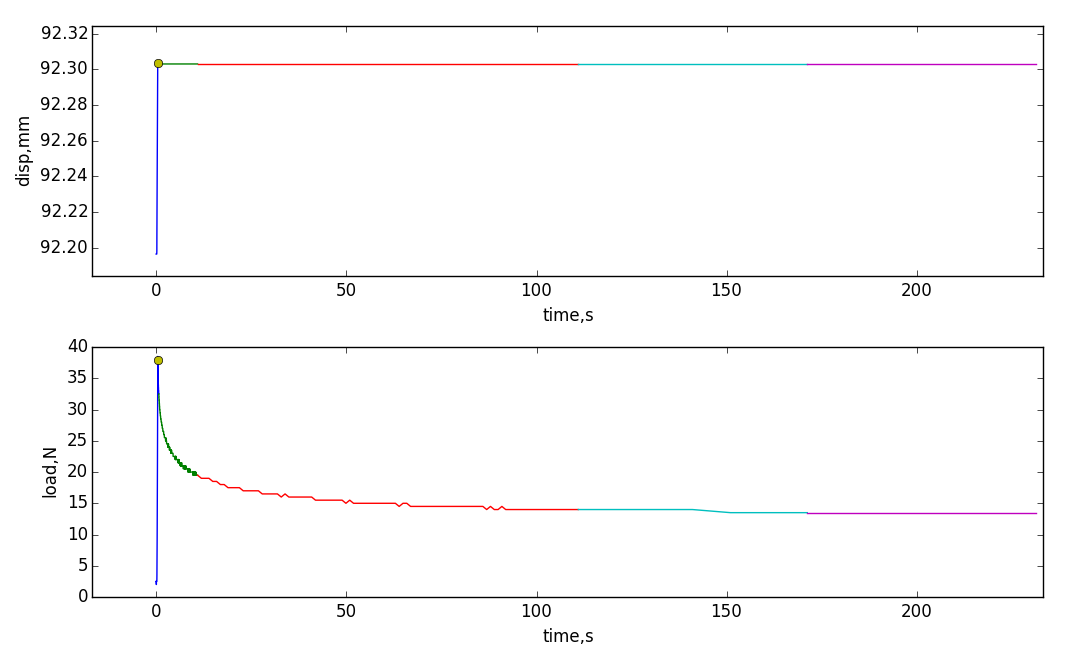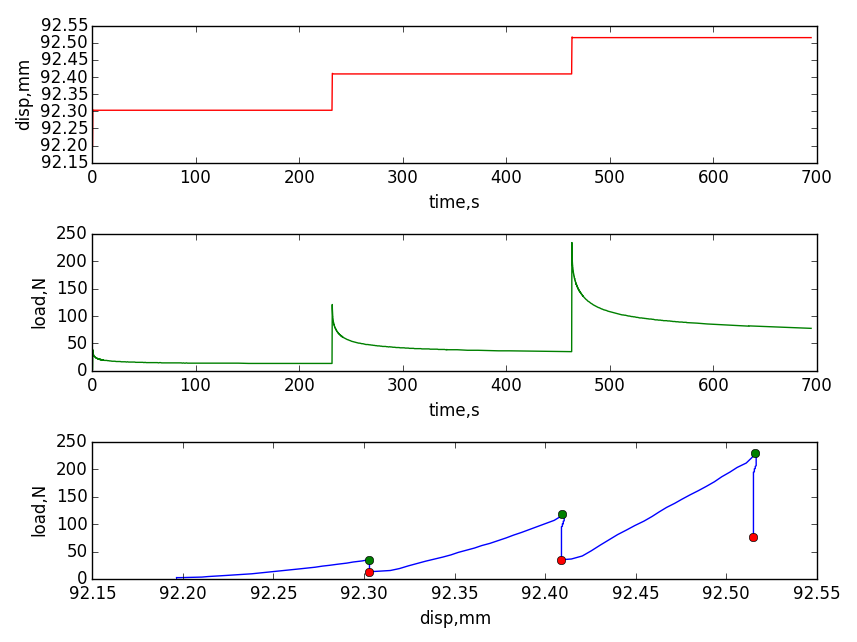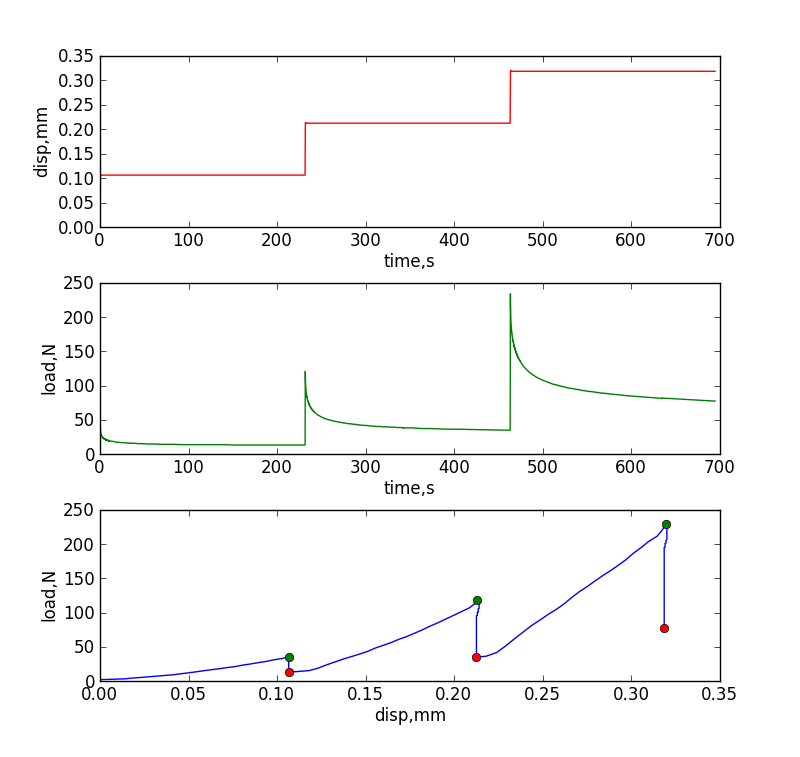Contents
-
Synopsis
- Repeatability of test protocols without changing the test environment
- Repeatability of test protocols by changing test environment
- Assessment of desired rates and strain levels
- Assessment of force and displacement data alignment
- Zero force (find contact) with and without force filter
- Assessment of positioning of clamps to set zero position
- Length measurement repeatability and reproducibility
- Thickness measurement repeatability and reproducibility
- Assessment of uncertainties associated with fluid forces and inertial forces
- Standardization of camera positions using bigger lens
- Timeline
- Evaluation tools
Synopsis
- All the attempts to evaluate the tissue mechanical testing and related protocols will be documented on this page. These excersices will help determine the capabilities of the testing system, quality of data and the feasibility of protocols.
Note: The force data will not be filtered.
- Force displacement data will be acquired at 100 Hz.
- Load cell calibration will be confirmed at the beginning of the test day.
Appropriate changes will be made to Specifications/ExperimentationTissueMechanics once evaluation of protocols is complete.
Details of testing protocols can be found at Specifications/ExperimentationTissueMechanics
Note: After the repeatability test of each tissue type, the sample will be stored in the refrigerator if tests are going to be repeated the next day, to avoid effects of multiple freeze-thaw cycles.
- Depending on the tissue type, different force transducers will be used.
- Samples used for repeatability tests are different from samples used to optimize other factors before actual tests.
- Both LVDT and optical thickness measurements will be done for these set of tests.
-- colbrunn 2015-10-27 16:12:05 there was quite a bit of work you put into getting the acceleration and other parameters right. Somehow we need to capture what we learned so that somebody can verify that they are doing the right things. In addition, our "right" way to do it is still a compromise from the ideal plan. Explain what you have learned and the limitations we will accept would be great to capture. There could just be a link here to the page that captures all of this investigation.
Repeatability of test protocols without changing the test environment
- This exercise will be used to evaluate whether the Mach 1 system can apply the same controls when the test environment is not changed. This will also help to determine whether there was any tissue damage/ altered tissue state during the test (if the controls remain the same).
- Ligament tensile test
- A ligament tensile sample will be tested at 3%, 6% and 9% strain at 20%/s strain rate.
- After the completion of first test, the sample will be allowed to rest in an unloaded state for 30 min.
- The sample will not be removed from the test environment.
- The sample will be tested again at 3%, 6% and 9% strain at 20%/s strain rate.
- Cartilage unconfined compression test
- A cylindrical cartilage sample will be tested under unconfined compression at 5%, 10% and 15% strain at 20%/s strain rate.
- After completion of the test, the sample will be allowed to rest in an unloaded state for 30 min.
- The sample will not be removed from the test environment.
- The sample will be tested again at 5%, 10% and 15% strain at 20%/s strain rate.
- Cartilage confined compression test
- Sample used for unconfined compression will now be tested under confined compression.
- All steps described above for unconfined compression test will be repeated.
- Cartilage tensile test
- A cartilage tensile sample will be tested at 5%, 10% and 15% strain at 20%/s strain rate.
- After completion of the test, the sample will be allowed to rest in an unloaded state for 30 min.
- The sample will not be removed from the test environment.
- The sample will be tested again at 5%, 10% and 15% strain at 20%/s strain rate.
- Meniscus unconfined compression test
- A cylindrical meniscus sample will be tested under unconfined compression at 5%, 10% and 15% strain at 20%/s strain rate.
- After completion of the test, the sample will be allowed to rest in an unloaded state for 30 min.
- The sample will not be removed from the test environment.
- The sample will be tested again at 5%, 10% and 15% strain at 20%/s strain rate.
- Meniscus confined compression test
- Sample used for unconfined compression will now be tested under confined compression.
- All steps described above for unconfined compression test will be repeated.
- Meniscus tensile test
- A meniscus tensile sample will be tested at 5%, 10% and 15% strain at 20%/s strain rate.
- After completion of the test, the sample will be allowed to rest in an unloaded state for 30 min.
- The sample will not be removed from the test environment.
- The sample will be tested again at 5%, 10% and 15% strain at 20%/s strain rate.
Evaluation metrics
- Parameters to be evaluated: Root mean square error between forces as well as displacements (peak and relaxed) between tests conducted at the given strain rate.
- This comparison will be done for all tissue and test types.
Analysis
Conclusion
Repeatability of test protocols by changing test environment
- The goal of this exercise is to evaluate whether repeating the test protocols by removing it from the test set up and repeating all the preparation steps before testing it again will produce the same results (evaluated through material property identification) provided the sample was not damaged during testing.
- The samples tested in previous section will be removed from the test set up and stored either at room temperature if test is going to be repeated the same day or in the refrigerator if the test is repeated the next day.
- Sample dimensions will be measured again before testing.
- Ligament tensile test
- A ligament tensile sample will be tested at 3%, 6% and 9% strain at 20%/s strain rate.
- Cartilage unconfined compression test
- A cylindrical cartilage sample will be tested under unconfined compression at 5%, 10% and 15% strain at 20%/s strain rate.
- Cartilage confined compression test
- Sample used for unconfined compression will now be tested under confined compression.
- Steps described above for unconfined compression test will be repeated.
- Cartilage tensile test
- A cartilage tensile sample will be tested at 5%, 10% and 15% strain at 20%/s strain rate.
- Meniscus unconfined compression test
- A cylindrical meniscus sample will be tested under unconfined compression at 5%, 10% and 15% strain at 20%/s strain rate.
- Meniscus confined compression test
- Sample used for unconfined compression will now be tested under confined compression.
- Steps described above for unconfined compression test will be repeated.
- Meniscus tensile test
- A meniscus tensile sample will be tested at 5%, 10% and 15% strain at 20%/s strain rate.
Evaluation metrics
- Parameters to be evaluated: moduli values
- This comparison will be done for all tissue and test types.
Analysis
Conclusion
Assessment of desired rates and strain levels
- The data acquired with all the previous tests will be evaluated to make sure the applied rates and strain levels match the desired rates and strain levels.
- Note: A python script is being developed to analyze the data quality as soon as the data is acquired (parameters of interest will be applied rates ans strain levels, expected time taken vs desired time taken, instantaneous and relaxed moduli calculation as well as plotting data to visually inspect data quality).
Evaluation metrics
- Parameters to be evaluated: Difference between desired and applied rates and strain level (% error).
Analysis
Conclusion
Assessment of force and displacement data alignment
- Provided the acquired data is not filtered the displacement and force data should align in time.
- The data acquired with the repeatability and reproducibility tests will be evaluated to make sure the displacements and forces are aligned.
Evaluation metrics
- Records of time stamps at the beginning and end of force and displacement.
Analysis
Conclusion
Zero force (find contact) with and without force filter
- It is recommended to not use any force data filtering during testing data acquisition. However, to find zero force / find contact for initial length measurement and contact with compression samples, it may be difficult to measure very low forces without using a filter.
- This evaluation will be done in two stages. First it will be determined which load cell will be appropriate for which tissue type based on previously acquired data. Based on this information filtered and unfiltered lowest force values will be obtained for each load cell. Second, the minimum force required to make contact with compression sample/stretch tensile sample will be determined.
- A very slow rate (0.005mm/s) will be used for all the 'find contact' stages.
Evaluation metrics
- Lowest force required to establish contact with / stretch tissue, with or without force filter.
Analysis
Conclusion
- After an extensive evaluation of load cell- tissue- test type combinations, it was concluded that using force filter would be appropriate for finding contact/ straightening the sample. Also, minimum forces required for each sample/ test type were determined. The force data during actual test will not be filtered. A low displacement rate of 0.005 mm/s will be used for all 'find contact' portions of test protocols. It is recommended that in case of compression samples the indentor is brought as close to the sample as possible to avoid effect of fluid forces.
Assessment of positioning of clamps to set zero position
- As the zero position of the clamps for tensile tests is set manually through visual inspection, it may be under or overestimated.
- To assess effects of experimenter error, two users will test the systems one after the other. First user will zero the position of the clap randomly and move the clamp till it is aligned with the other clamp and make a note of the distance moved. He/she will move the clamp away from the aligned position. Second user will then align the clamps and note the distance moved. The two distances recorded by the users will be compared to assess user error.
- The alignments with the clamps placed front to back and side by side will be evaluated.
Evaluation metrics
- A visual estimate of zero position of user two will be compared to value showing on the screen from previous user's estimate of zero position.
Analysis
Conclusion
- The front to back alignment work better and should be used.
- There was a maximum 50 micron difference (0.01% of a 5mm long sample) in visual estimation of alignment between users.
Length measurement repeatability and reproducibility
- For this test a ligament tensile sample, a meniscus tensile sample and a cartilage tensile sample will be used.
- To test repeatability of the procedure, the samples lengths will be measured 5 times
- without removing the sample from the test set up.
- 'Find contact' force values obtained previously will be used.
Evaluation metrics
Analysis
Conclusion
- The goal was to assess whether same tensile length is achieved repeatedly with the same min find contact force.It appears that for all the samples tested the standard deviation was small (e.g. 0.0287 for 13.5144mm mean length). This indicates the repeated length measurements were close to each other. For length measurements force data was filtered.The rate used (0.005mm/s) and a careful attachment of the sample at the grips would prevent any additional factors in potentially damaging the sample before or during the tests.
Thickness measurement repeatability and reproducibility
- For this test a ligament tensile sample, cartilage compression sample,a cartilage tensile sample, a meniscus compression sample and a meniscus tensile sample will be used.
- To test repeatability of the procedure, the samples thicknesses will be measured 3 times in lvdt thickness measurement system (each time 5 measurements are taken on the sample and averaged) without moving the sample.
- The sample will be removed and put back in the set up and thickness will be measured (5 measurements on each sample).
- The above step will be repeated.
- Thicknesses will be measured using the OTMS.
- Samples will be removed from the OTMS set up and put back on and remeasured for thickness values.
Evaluation metrics
- Average thickness values and standard deviations will be reported.
Analysis
Conclusion
Assessment of uncertainties associated with fluid forces and inertial forces
- To assess the effect of fluid forces, buoyancy and inertia on the resultant forces (load cell measurements), for each load cell, various expected strain rates will be tested.
- These tests will be conducted with the indentor close to the surface of the water (fully submerged) in case of compression samples as well as at the approximate depth at which tests will be actually conducted.
- In case of tensile samples the assessment will done at the depth approximately close to where the samples will be.
- Force data will be filtered.
- Peak forces will be noted.
Evaluation metrics
- Peak forces.
Analysis
Conclusion
- The forces observed were low (e.g: 0.18g for a cartilage compression sample that experiences 40-50g force of 5% strain). It was concluded that these effects can be ignored. However, to further minimize these effects, in case of compression samples the indentor should be brought as close to the sample as possible before testing (without establishing contact)and for tensile samples the sample can be manually straightened (not completely and without any load on the sample).
Standardization of camera positions using bigger lens
- A simple set up will be built for optical tissue thickness measurement (OTTM).
- A base with a fixed platform fitted with a standard precision gage will be built.
- A blue background will be attached to the far edge of the base.
- Distance needed for an optimal image for any tissue placed on the platform will be estimated using the current camera and Mach 1 base.
- This distance will be used to attach a camera to the base of OTTM system. the field of view should cover the sample entirely as well as the height of the gage.
- see details in Specifications/ExperimentationTissueThickness
Timeline
Note: The events are organized based on their dependability on results from previous events. Some time might be needed between events to evaluate collected results to decide the progression of following events.
- Development of measurement and analyses tools.
- Day 1-10: Design and build optical tissue thickness measurement system.
- Day 1-10 : Python scripting for data analysis.
- Protocol assessment
- Day 11: Assessment of positioning of clamps to set zero position AND standardization of camera positions using bigger lens.
- Day 12: Data collection for assessment of thickness measurement LVDT and optical.
- Day 13: Assessment of zero force (find contact) with and without force filter AND assessment of length measurement repeatability and reproducibility.
- Day 14: Repeatability data collection for ligament tensile test.
- Day 15: Repeatability data collection for cartilage unconfined compression test.
- Day 16: Repeatability data collection for cartilage confined compression test.
- Day 17: Repeatability data collection for cartilage tensile test.
- Day 18: Repeatability data collection for meniscus unconfined compression test.
- Day 19: Repeatability data collection for meniscus confined compression test.
- Day 20: Repeatability data collection for meniscus tensile test.
Evaluation tools
- Currently a python script is in development to analyze the tissue testing data immediately after the mechanical test is done. The goal of this script is to check the data quality for any discrepancy so that the test can be repeated if necessary.
- The repeatability analyses will also help to establish confidence in the testing system and protocols.
- Example: Three loading ramps for cartilage unconfined compression test. Data from 'Move Relative' command for three strain levels from the Mach1 system. Figure below shows displacement applied by the system and resultant loads.
- The script can also print the ramp and wait components of each strain and find the peaks and equilibrium displacement and load values.
- The script was modified to show all the ramp and wait data and peak and equilibrium data points.
- It can also calculate the rates applied and duration for each ramp which can be compared to the expected rates and duration.
- In the above example for unconfined compression for a cartilage sample, the expected rate was 0.424 mm/s (2.12 mm thick sample, 20%/s). The actual rates applied by the system are 0.435mm/s, 0.4457mm/s and 0.4451 mm/s.



